
Source: PaxForex Premium Analytics Portal, Fundamental Insight
Last year AT&T decided to spin off its DIRECTV and WarnerMedia divisions in 2021 to raise capital to reduce its huge debt. Many shareholders no doubt hoped that this would preserve the dividend streak that had made the company a Dividend Aristocrat.
Unfortunately for investors, AT&T said last year that it intended to cut payouts despite the cash the company would receive from the split. Now that its status as a Dividend Aristocrat has been lost, such moves understandably make AT&T investors question whether AT&T is still a great dividend stock.
In AT&T's Q2 2021 10-Q filing with the Securities and Exchange Commission, the company said it would adjust its payout distribution to about $8-9 billion a year after the Warner Media spin-off is completed. Since AT&T distributed nearly $15 billion to shareholders in 2020 (and probably also in 2021), this would significantly reduce the payout.
With this dividend adjustment, AT&T ends a series of consecutive payout increases that began in the mid-1980s. There is no obligation for companies to pay dividends. For this reason, income investors tend to rely on the dividend increase streak to maintain their confidence in the payout. In the absence of such a streak, income investors may turn their attention to other stocks.
Despite this confidence problem, some analysts argue that lower payouts will help AT&T begin its recovery in 2022. The $2.08 annual payout represented 8% of cash earnings, well above the S&P 500's return of about 1.25%. Moreover, the total debt of $179 billion represents a huge burden on a company worth $181 billion when liabilities are subtracted from assets.
From this perspective, the asset separation and dividend cost reduction bring AT&T a welcome relief. In the DIRECTV spin-off, 30 percent of DIRECTV's assets were sold, bringing the company more than $7 billion. After AT&T completes the WarnerMedia spin-off, it will receive $43 billion.
These proceeds, as well as savings from dividend cuts, are expected to allow AT&T to reduce its debt. And divesting from those businesses will make the company more similar to its 5G-focused peers, T-Mobile and Verizon, although Verizon once invested a total of $9 billion in Yahoo! and AOL before spinning off those businesses.
The spin-off would also provide capital to keep AT&T competitive. In the first nine months of 2021, AT&T
spent nearly $13 billion on capital spending, accounting for 10 percent of its operating income. During the same period, Verizon spent about 14% of its revenue on capital spending, and T-Mobile allocated 22% of its revenue to fixed assets, indicating that AT&T may have to increase spending.
Still, the pay cut may give investors little reason to buy the stock, which has suffered for decades. AT&T stock first reached its current price in the mid-1990s. Although it has fluctuated since then, dividend income has represented a positive return on AT&T stock in many cases.
Moreover, AT&T's dividend investors may decide to turn to its longtime nemesis, Verizon. Verizon's annual payout of $2.56 per share currently generates 5% cash earnings. And while Verizon is not a Dividend Aristocrat, its 17-year streak of payout increases could boost confidence in the stock. Verizon is also heavily indebted, but it easily produces enough cash flow to cover the cost of dividends and modest annual raises. For the first three quarters of last year, Verizon received $17B in FCF and paid $8B in dividends. Verizon's total debt is $151B.
Moreover, while the asset spinoff and dividend cut should reduce AT&T's debt, the company's liabilities will likely continue to weigh on it. Even if the funds from the spin-off go to reduce debt, AT&T would still have $129B in debt. That represents about 71% of the company's equity -- the value of AT&T after deducting liabilities from assets.
While the payout cut will likely keep the dividend yield well above the S&P 500 average, high-net-worth investors may want to stay away from AT&T stock. The lack of growth since the mid-1990s does not give growth stock investors much reason to be optimistic.
Moreover, income-oriented investors are no longer protected by a succession of pay raises. Thus, AT&T could cut payouts even further if it needed money to reduce debt or capital expenditures. Given this danger, AT&T will have to spend years trying to prove that it can sustain a series of payout increases before dividend investors can regain confidence in the telecommunications company's stock.
As long as the price is above the 25.10 level, follow the recommendations below:
- Time frame: D1
- Recommendation: long position
- Entry point: 26.25
- Take Profit 1: 28.40
- Take Profit 2: 29.20
Alternative scenario:
If the level of 25.10 is broken-down, follow the recommendations below:
- Time frame: D1
- Recommendation: short position
- Entry point: 25.10
- Take Profit 1: 23.70
- Take Profit 2: 22.80













